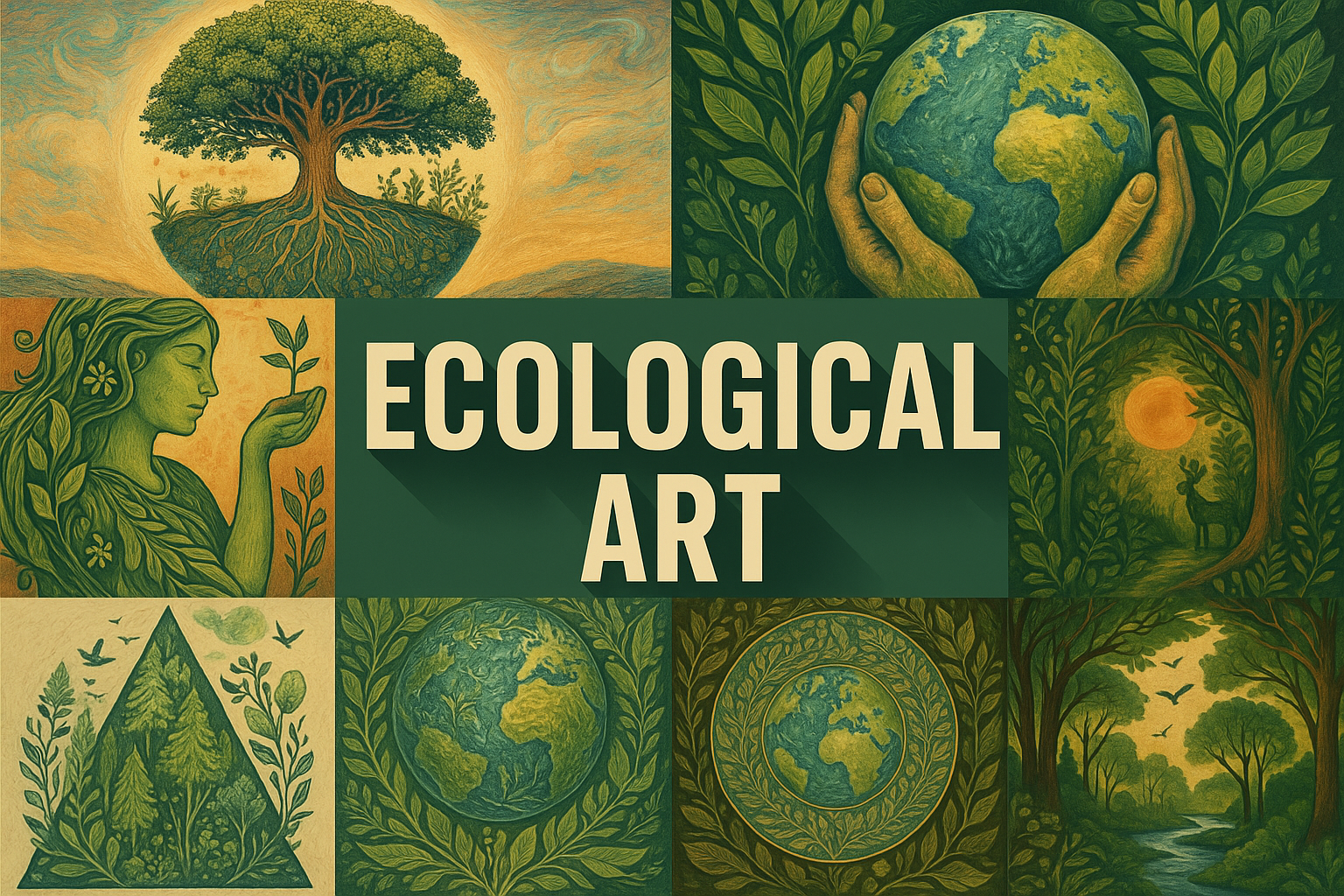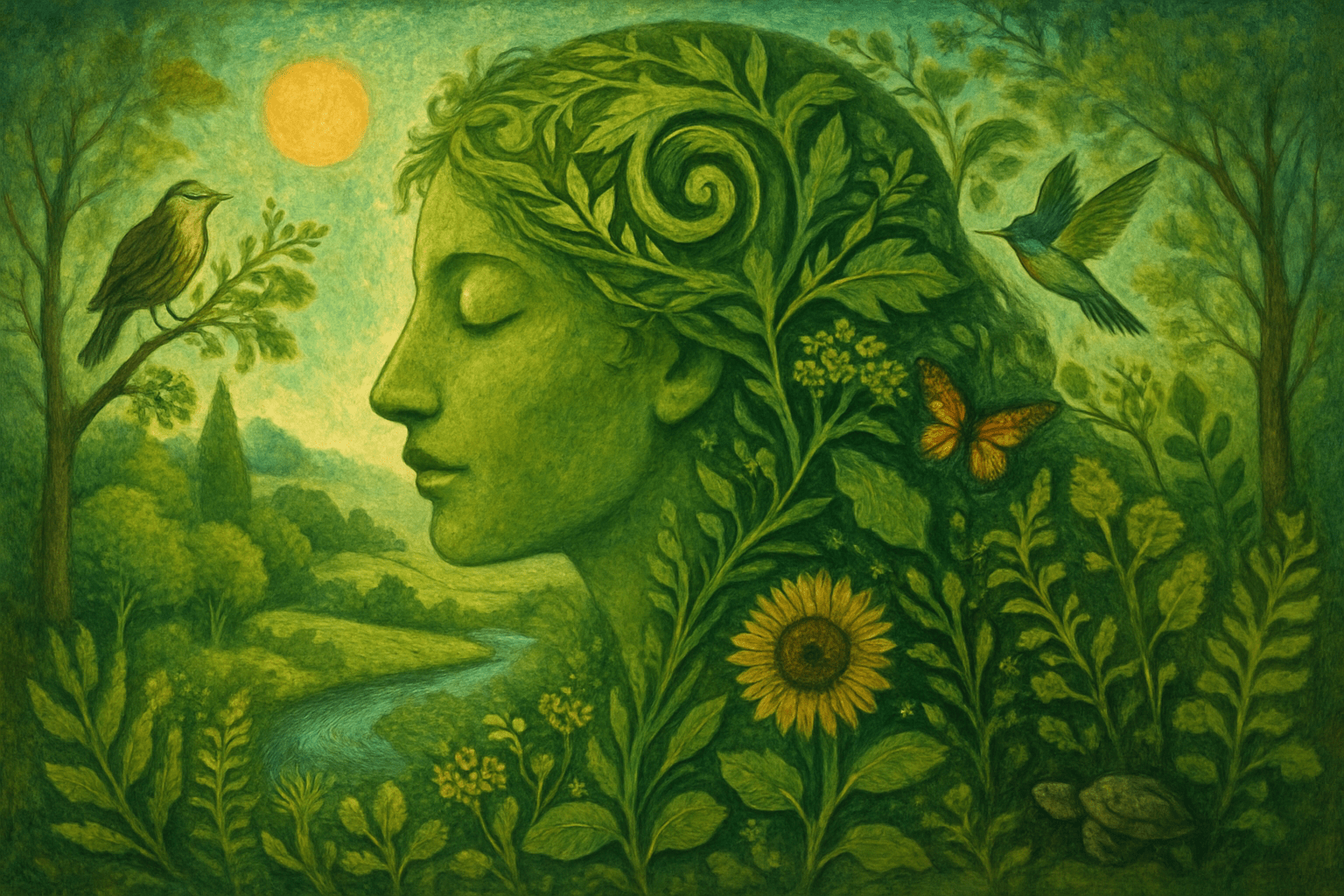
Ecological Art
Ecological Art is a type of art that is focused on the environment and the relationship between humans and nature. This type of art often uses natural materials, such as leaves, branches, and rocks, and incorporates them into the artwork. Ecological Art is often colorful and whimsical, and often has a message about the importance of protecting the environment.
AOI thinking about Ecological Art [+_~]-/
Overview and Quickfacts
Ecological Art is a term used to describe art that is based on or inspired by nature. This type of art can be found in many different forms, including painting, sculpture, photography, and even architecture. Ecological Art often has a message or purpose behind it, such as raising awareness about environmental issues.
Can understand it also, as:
Nature Art, Environmental Art, Green Art
Categorize it as:
Impressionism, Modernism
.: Dreaming :.
holds a HAIKU for the art style
:. Thought is power .:
Detailed Description
Ecological Art, also known as ecoart and environmental art, is a genre of art that is concerned with the natural world and our relationship to it. Ecoart often includes elements of nature, such as plants, animals, and landscapes, as well as environmental themes, such as pollution, climate change, and habitat loss. Ecoart can take many different forms, from traditional paintings and sculptures to more experimental installations and performances. Some ecoartists work with natural materials, such as soil, rocks, and leaves, while others use recycled or upcycled materials, such as plastic bottles and tires. Ecoartists often seek to raise awareness about environmental issues and to encourage viewers to take action to protect the planet. Many ecoartworks are site-specific, meaning they are designed to be installed in a specific location and interacted with by the public. Some of the most famous ecoartists include Andy Goldsworthy, who creates temporary sculptures using leaves, sticks, and stones; Christo and Jeanne-Claude, who wrapped the Reichstag in fabric; and Maya Lin, who designed the Vietnam Veterans Memorial in Washington, D.C. If youÃÂÃÂre interested in learning more about ecoart, be sure to check out the resources below. And if youÃÂÃÂre looking for some eco-friendly art to add to your collection, be sure to check out the work of these artists. Famous Ecoartists: Andy Goldsworthy Christo and Jeanne-Claude Maya Lin Nancy Holt Robert Smithson Walter De Maria Famous Ecoartworks: The Wrapped Reichstag by Christo and Jeanne-Claude The Vietnam Veterans Memorial by Maya Lin The Spiral Jetty by Robert Smithson The Lightning Field by Walter De Maria Resources: Ecoartspace: A nonprofit organization that supports ecoartists and promotes ecoart Ecoartnet: An online network of ecoartists Artists and Climate Change: A website that explores the intersection of art and climate change
.. beep, beep, beep ..
<START OF TRANSMISSION>
1. Ecological art is a type of art that is concerned with the environment and the relationship between humans and nature. 2. It often includes elements of nature, such as plants, animals, and landscapes. 3. Ecological art can be used to raise awareness about environmental issues. 4. It can also be used to promote sustainable living practices. 5. Ecological art often incorporates recycled materials. 6. It can be created using a variety of mediums, including painting, sculpture, and photography. 7. Ecological art often has a message or story to tell about the environment. 8. It can be educational, as well as aesthetically pleasing. 9. Ecological art can be found in a variety of settings, including galleries, museums, and public spaces. 10. Many ecological artists work collaboratively with others, including scientists, engineers, and architects. 11. Ecological art often uses natural processes, such as photosynthesis, to create its effects. 12. It can be temporary or permanent. 13. Ecological art can be interactive, involving the viewer in the creative process. 14. It can be site-specific, created specifically for a particular location. 15. Ecological art often has a spiritual or meditative quality. 16. It can be used to create healing environments. 17. Ecological art can be used to connect people with nature. 18. It can inspire people to take action to protect the environment. 19. Ecological art is often beautiful and inspiring. 20. Ecological art can make a difference in the world.
<EOF>
.. robbel bob
Visual Examples from our image gallery
Coming soon, we are so slow .. might never come
Artists, Paintings, and more
(be aware, can be highly speculative)
Artists (be aware, speculation possible):
1. Andy Goldsworthy (b. 1956) 2. Ana Mendieta (1948-1985) 3. Billie Lawless (b. 1957) 4. Chris Drury (b. 1949) 5. David Nash (b. 1945) 6. Dennis Oppenheim (1938-2011) 7. Eva Hesse (1936-1970) 8. Felix Gonzalez-Torres (1957-1996) 9. Gordon Matta-Clark (1943-1978) 10. Hans Haacke (b. 1936) 11. Helen and Newton Harrison (b. Newton: 1931; Helen: 1928) 12. James Turrell (b. 1943) 13. Jenny Holzer (b. 1950) 14. John Cage (1912-1992) 15. Joseph Beuys (1921-1986) 16. Land Art Generator Initiative 17. Maya Lin (b. 1959) 18. Michael Heizer (b. 1944) 19. Nancy Holt (1938-2014) 20. Robert Smithson (1938-1973) 21. Roger Hiorns (b. 1975) 22. Theaster Gates (b. 1973) 23. Theresa Hak Kyung Cha (1951-1982) 24. Walter De Maria (1935-2013) 25. Yoko Ono (b. 1933) 26. Ai Weiwei (b. 1957) 27. Cristina Iglesias (b. 1956) 28. Doris Salcedo (b. 1958) 29. Janet Echelman (b. 1966) 30. Olafur Eliasson (b. 1967)
Artworks (be aware, speculation possible)
1. “The Hay Wagon” by Andrew Wyeth (1947) 2. “American Gothic” by Grant Wood (1930) 3. “Nighthawks” by Edward Hopper (1942) 4. “One of the First Things” by Georgia O’Keeffe (1918) 5. “Mural” by Jackson Pollock (1943) 6. “The Persistence of Memory” by Salvador Dali (1931) 7. “The Scream” by Edvard Munch (1893) 8. “The Starry Night” by Vincent van Gogh (1889) 9. “The Kiss” by Gustav Klimt (1908) 10. “The Sleeping Gypsy” by Henri Rousseau (1897) 11. “The Haystacks” by Claude Monet (1891) 12. “The Water Lilies” by Claude Monet (1919) 13. “The Poppy Field” by Claude Monet (1873) 14. “The Wheat Field” by Vincent van Gogh (1890) 15. “The Cafe Terrace on the Place du Forum” by Vincent van Gogh (1888) 16. “The Sower” by Vincent van Gogh (1888) 17. “The Bedroom” by Vincent van Gogh (1889) 18. “Sunflowers” by Vincent van Gogh (1888) 19. “The Mulberry Tree” by Vincent van Gogh (1889) 20. “Irises” by Vincent van Gogh (1890) 21. “The First Snow” by Claude Monet (1874) 22. “The Red Poppy” by Georgia O’Keeffe (1927) 23. “The Black Iris” by Georgia O’Keeffe (1926) 24. “Cow’s Skull: Red, White, and Blue” by Georgia O’Keeffe (1931) 25. “Radiant Orchid” by Georgia O’Keeffe (1928) 26. “Pelvis with Blue” by Georgia O’Keeffe (1944) 27. “Jimson Weed/White Flower No. 1” by Georgia O’Keeffe (1932) 28. “From the River” by Georgia O’Keeffe (1923) 29. “One Hundred and Fifty-Second Street” by Georgia O’Keeffe (1927) 30. “City Night” by Georgia O’Keeffe (1926)
Epoch
The time period of the art style Ecological Art is the late 20th century to the present.
AI ART RESSOURCES (AKA, well Tools)
Helping tools -> predefined search links on other pages:











